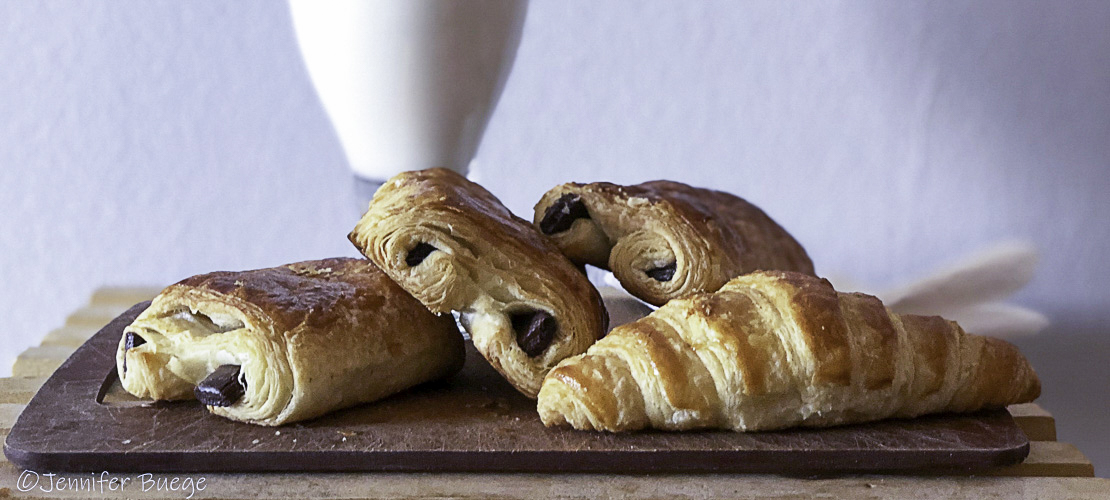
Homemade Croissants FTW
02-06-2021
At least once a winter, I find three days where I’ll be hanging around home (relatively easy these days) and make croissants. For years I’ve used the same recipe, with decent-tasting results. They weren’t usually, however, the lovelies that I had envisioned. I’ve always felt that I could do better, that I could master the process. Difficult, I realize, when I’m only making them once or twice a year. Or so I’ve been reminded. By the same person. More than once.
With plenty of time on my hands this winter, though, I decided to do a deep research dive into what you (I) need to do to make bakery-level croissants. What I found totally upped my croissant-making game.
This whole quest started when I decided that this year, I wanted to make chocolate croissants. I’m not talking pain au chocolat but croissants where the chocolate (most likely cocoa powder) was actually in the dough. I was surprised at how hard it was to find, but I finally stumbled across one that not only included a recipe but talked about all the research the blogger/baker had done to get there. And she provided links to her sources! For the life of me, I can’t find that post now, but I did bookmark the Chowhound thread – started in 2006! – that featured baker Ralph and that opened my eyes.
There’s a lot to scroll through. And while I recommend starting at page 1 and making your way through to the very end, those who just want the key info can skip to page 7, where Ralph kicks off a series of posts detailing the process he follows at his bakery. Make sure to read all the way through his posts – don’t just start baking – because he makes a correction toward the beginning that’s essential to weave into your work.
The biggest problem I tend to have is butter leaking out of my croissants during baking. I’d heard that this is caused by underproofing, but I feel like I’ve always gone above and beyond when proofing to try and avoid this. The fact that my croissants continued to leak showed that I was wrong. Instead of trying to exemplify the pop culture definition of “insanity,” this run I made an exaggerated proofing effort – I’m talking 4 or so hours – and it worked! No leakage. The other nifty, new-to-me trick that I learned was cutting off the rough edges before making your folds so as not to trap dead dough. Without doing a side-by-side comparison, it’s hard to tell what difference this had–but I can tell you that my croissants were flaky through and through.
Ralph bakes using weights and a formula. I prefer to weigh when I bake, but I wasn’t thrilled about dealing with the formula, so I applied his process to this recipe from Fine Cooking. I also referred to the step-by-step photos at Weekend Bakery. You can never have too much help!
Oh, the other incredibly helpful suggestion that I semi followed was to bake four batches, one each day, so that you’d learn how your oven reacts and so that you can adjust any errors. I miscalculated the amount of butter I’d need (another reason to go with the recipe versus working the formula), so I only made two batches across four days. It worked, though. I learned from my mistakes/questions from the first trial and incorporated my new smarts into the second, so-close-to-perfect-I-call-it-a-win batch. The last time I was in Paris, I bought a box of chocolate batons from G. Detou that I added to half the croissants. I even tried a new method: placing a baton on each side and rolling them toward each other. It’s fine and looks pretty, but I think I prefer the typical single roll.
The only downside to all of this was having almost 50 croissants on hand, during a pandemic. Of course, that’s also the upside. 😁 Fortunately, they keep well and there are still a few hanging out in my freezer waiting for my next coffee break.
I’m so excited to try these again, especially after having come across a few other ideas for kicking things up a notch:
- A recipe for Bi-Color Chocolate S’mores Croissants from Peaches 2 Peaches. They’re absolutely gorgeous!
- Another recipe from Peaches 2 Peaches for Cinnamon-Sugar Cruffins with Nutella that introduced me to…
- Using your pasta machine to roll out croissant dough! Lady and Pups makes cruffins this way and has detailed photos to walk you through the process.
Happy baking!